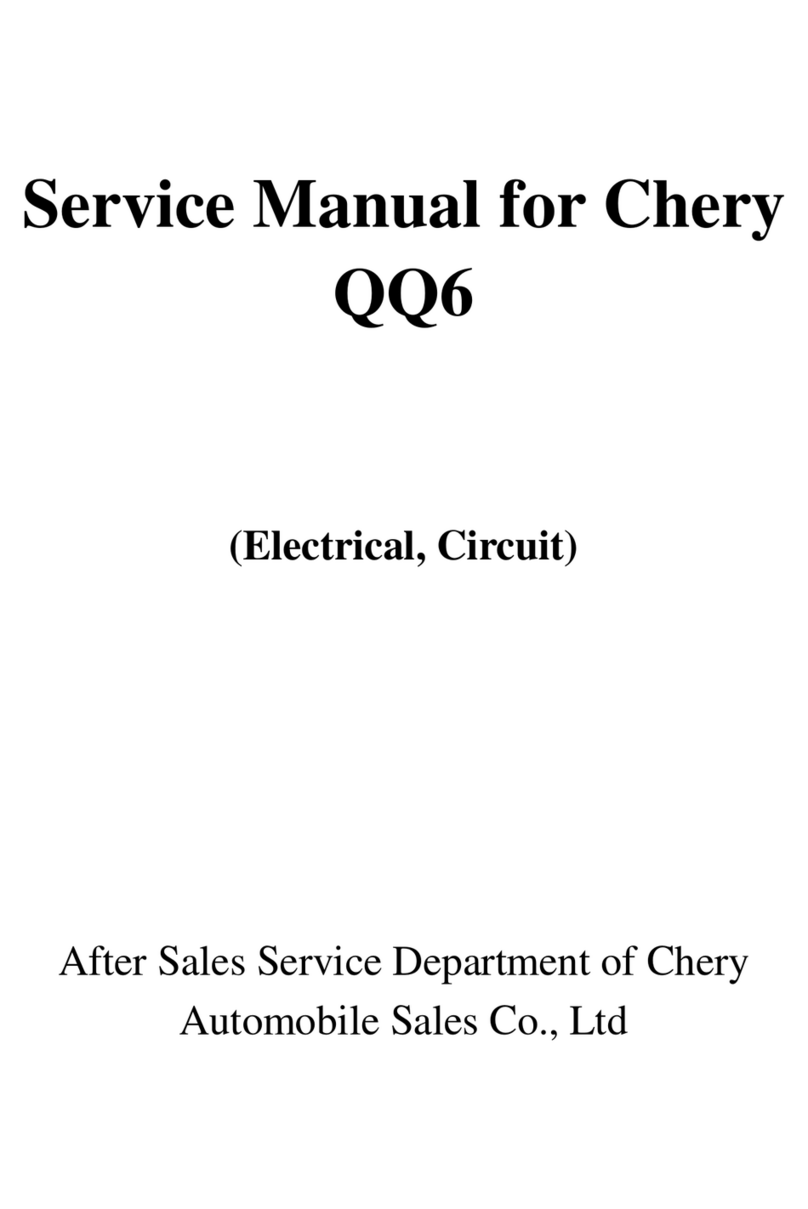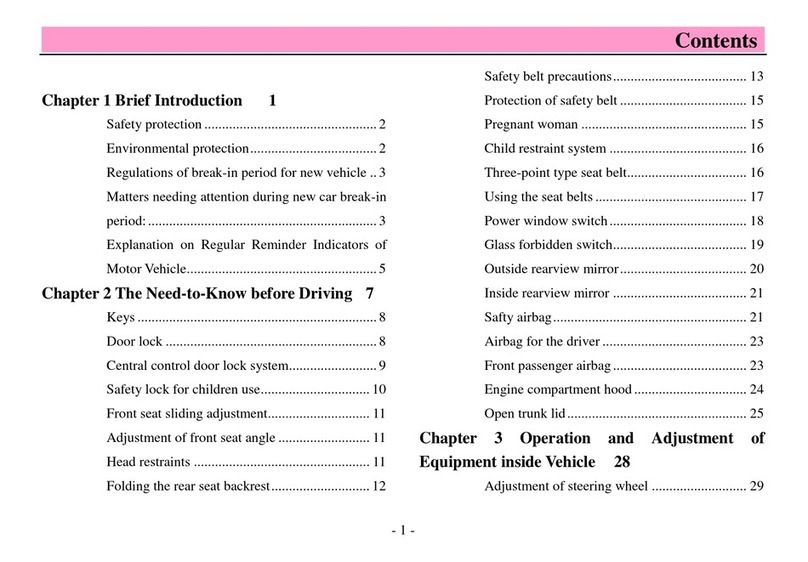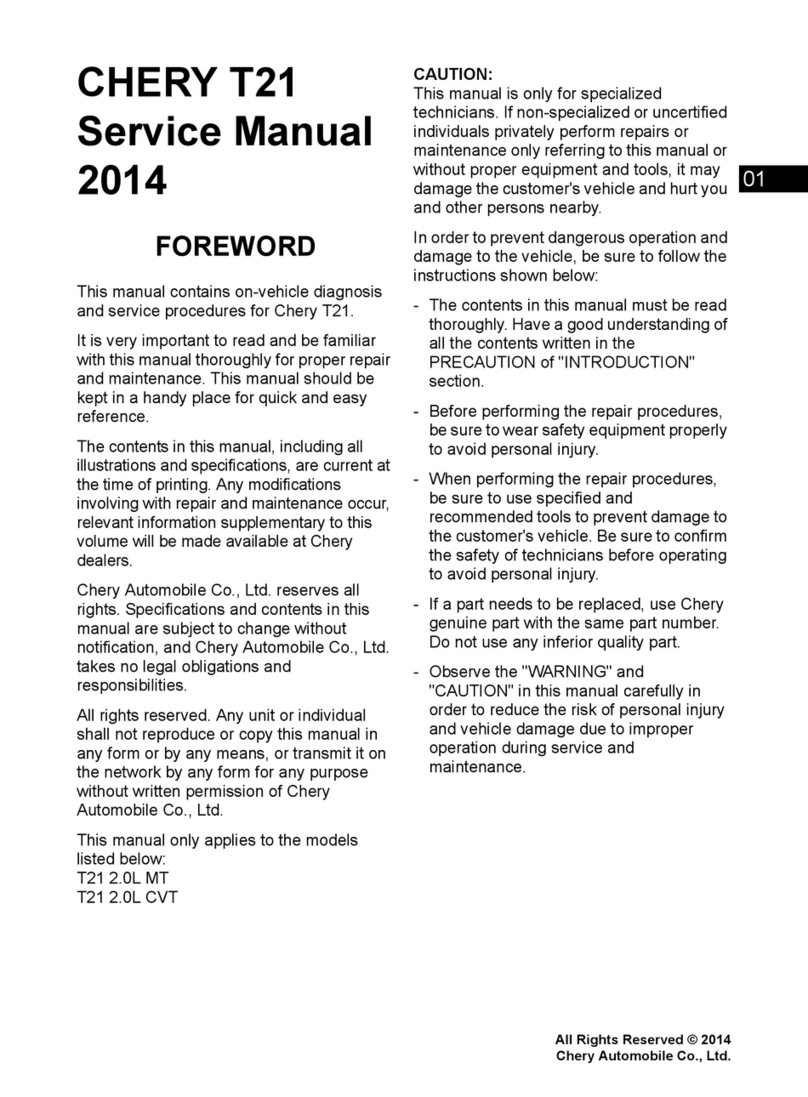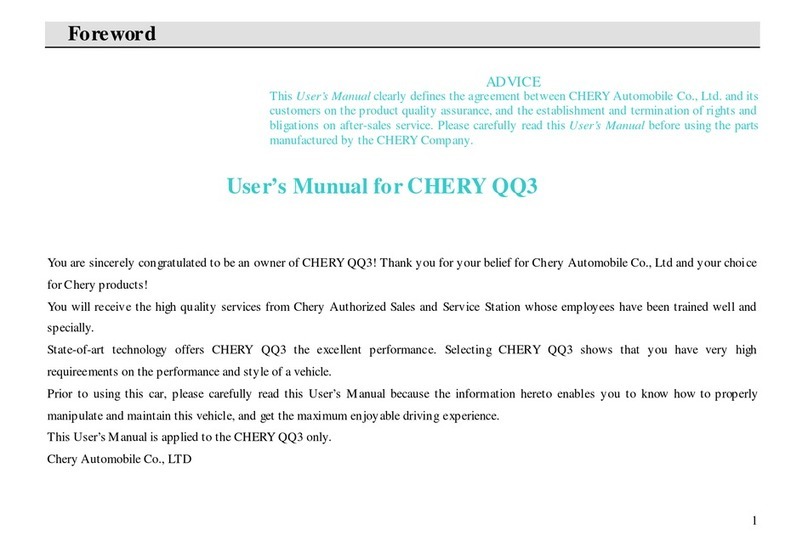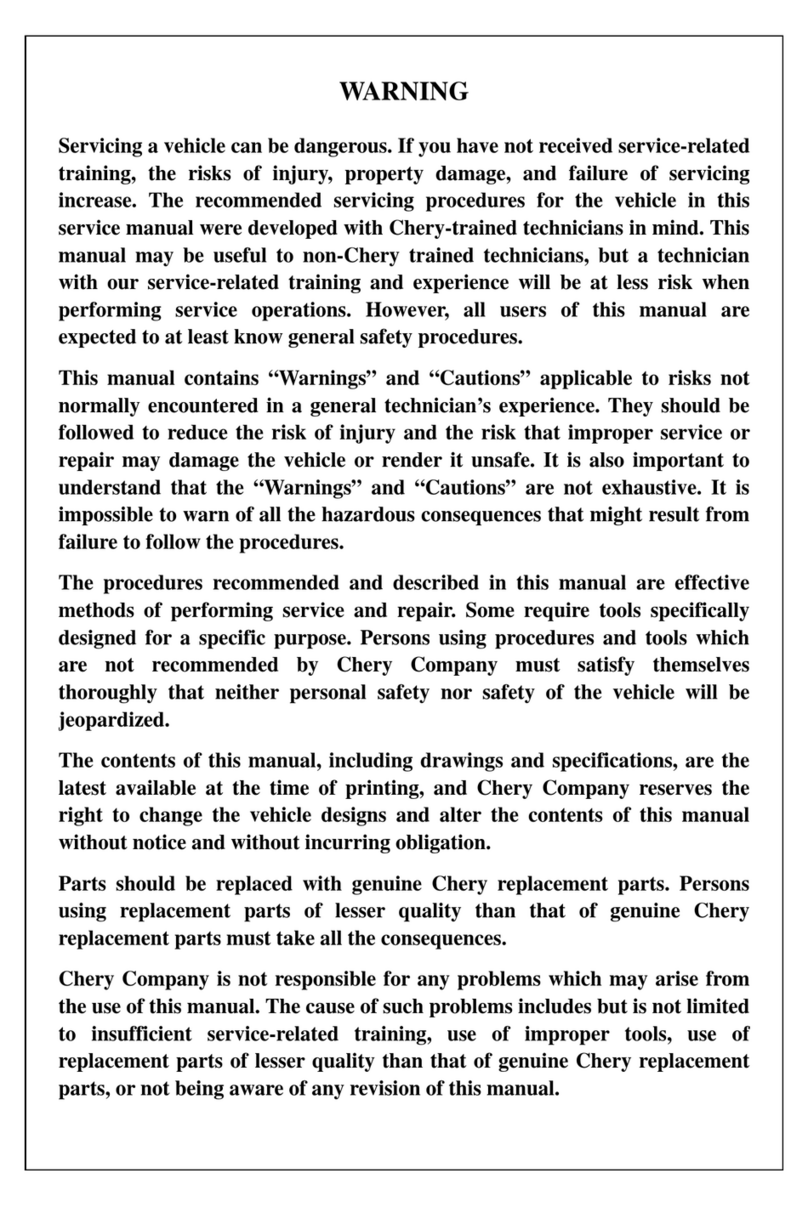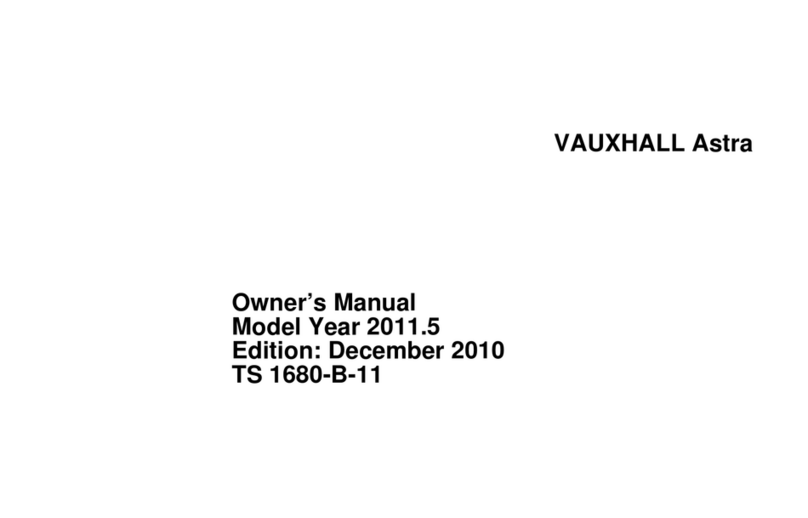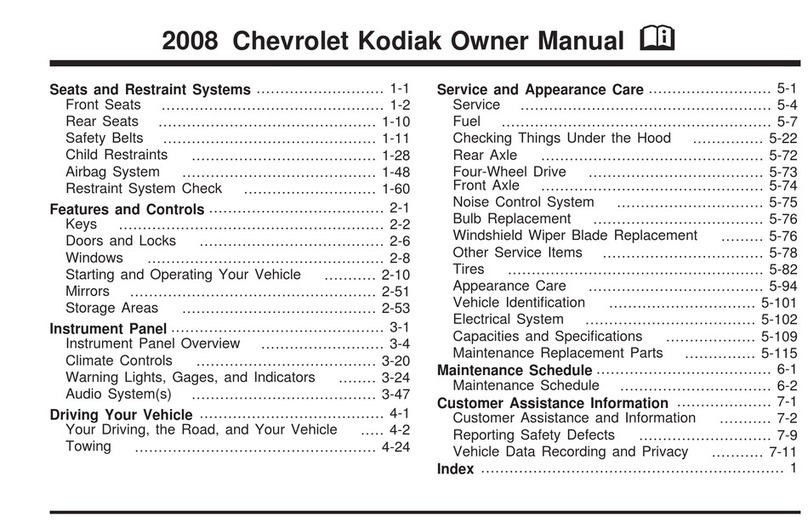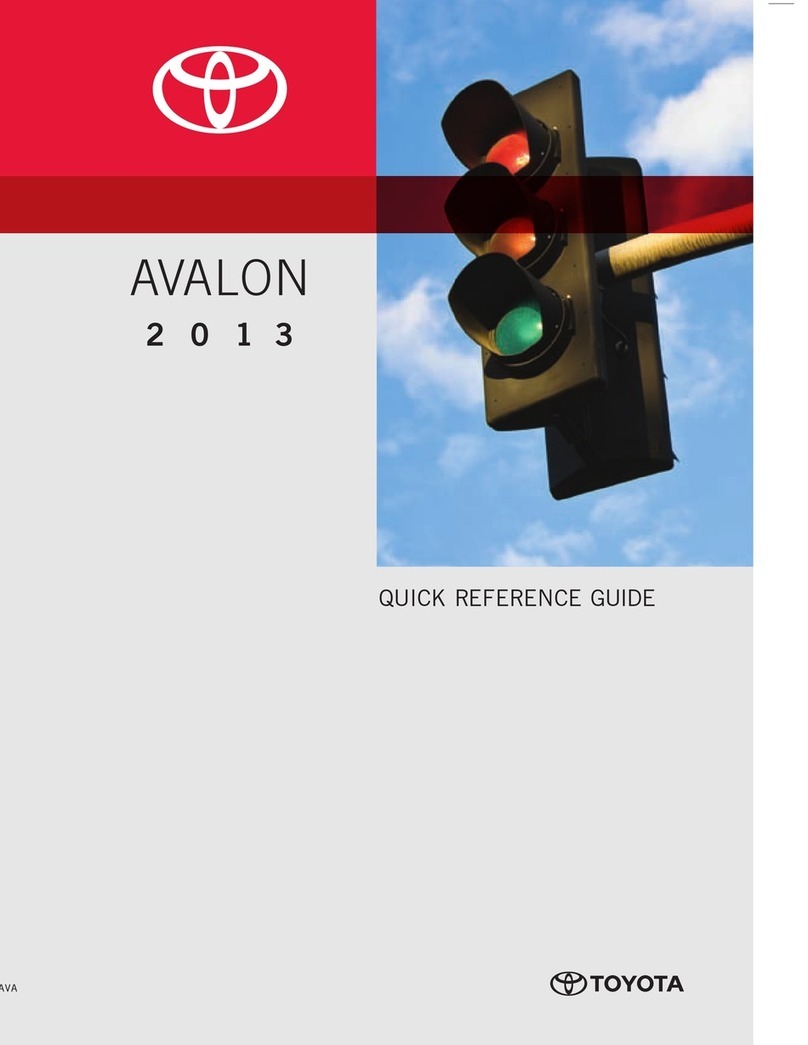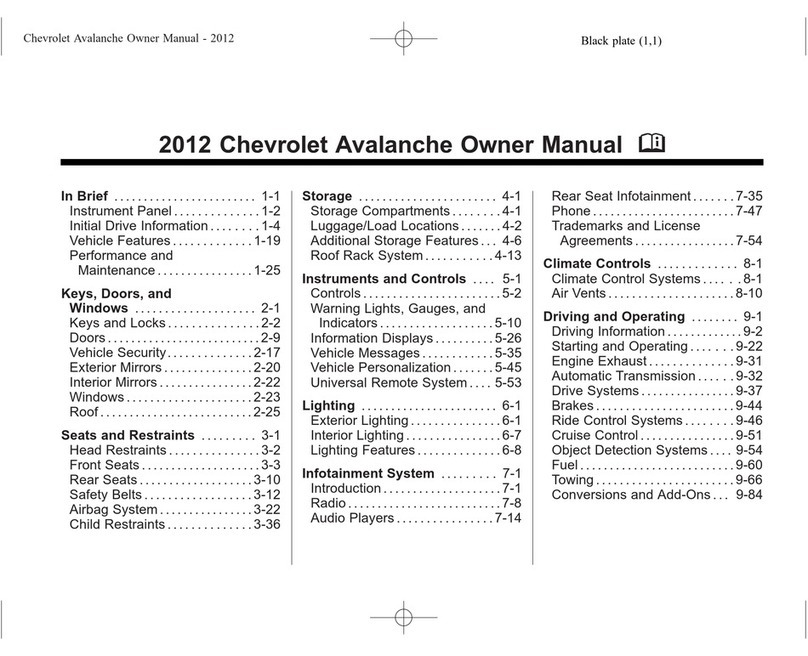Chery A1 2009 User manual

2009
CHERY
A1
Service Manual
FOREWORD
This manual contains on-vehicle service
and diagnosis procedures for the Chery A1.
A thorough familiarization with this manual
is important for proper repair and
maintenance. It should always be kept in a
handy place for quick and easy reference.
The contents of this manual, including
drawings and specifications, are the latest
available at the time of printing. As
modifications affecting repair or
maintenance occur, relevant information
supplementary to this volume will be made
available at Chery dealers. This manual
should be kept up-to-date.
Chery Automobile Company, Ltd. reserves the
right to alter the specifications and
contents of this manual without obligation
or advance notice.
All rights reserved. No part of this book
may be reproduced or used in any form or
by any means, electronic or mechanical—
including photocopying and recording and the
use of any kind of information storage and
retrieval system—without permission in
writing.
NOTE:
This A1 service manual only applies to the follow-
ing engines and transaxles:
•1.3L with M/T
•1.3L with AMT
Chery Automobile Company, Ltd.
Wuhu, Anhui Province, CHINA
CONTENTS
Title Section
GENERAL INFORMATION
01
ENGINE
02
ELECTRONIC ENGINE CONTROLS
03
FUEL DELIVERY
04
STARTING & CHARGING
05
COOLING
06
EXHAUST
07
TRANSAXLE
08
DRIVELINE & AXLE
09
SUSPENSION
10
STEERING
11
BRAKES
12
HEATING & AIR CONDITIONING
13
RESTRAINTS
14
BODY & ACCESSORIES
15
WIRING
16
ALPHABETICAL INDEX
AI
2009 Chery Automobile Co., Ltd.
PRINTED NOVEMBER, 2009

GENERAL INFORMATION
01
CONTENTS page
Service Information . . . . . . . . . . . . . . . . . . . . . . . . . . . . . . . . . . . . . . . . . . . . . . . . . . . . . . . . . . . . . . . . . . . 01-1
Vehicle Information . . . . . . . . . . . . . . . . . . . . . . . . . . . . . . . . . . . . . . . . . . . . . . . . . . . . . . . . . . . . . . . . . . . 01-9
Electrical Circuit Diagnosis Information . . . . . . . . . . . . . . . . . . . . . . . . . . . . . . . . . . . . . . . . . . . . . . . . . 01-15
Electrical Information . . . . . . . . . . . . . . . . . . . . . . . . . . . . . . . . . . . . . . . . . . . . . . . . . . . . . . . . . . . . . . . . 01-20
SERVICE INFORMATION
HOW TO USE THIS MANUAL 01-2
Topics 01-2
Service Procedures 01-2
Diagnostic Procedures 01-2
Specifications 01-2
VEHICLE SERVICE PREPARATION 01-3
Preparation For Vehicle Service 01-3
Tools and Testing Equipment 01-3
Special Tools 01-3
Disconnection of the Negative Battery
Cable 01-4
PROPER SERVICE PRACTICES 01-5
Removal of Parts 01-5
Component Disassembly 01-5
Inspection of Parts 01-5
Arrangement of Parts 01-6
Cleaning of Parts 01-6
Component Reassembly 01-6
Adjustments 01-7
Rubber Parts and Rubber Tubing 01-7
Hose Clamps 01-8
Vise 01-8
Dynamometer 01-8
01
01–1
Chery Automobile Co., Ltd.

HOW TO USE THIS MANUAL
Topics
This manual contains procedures for performing all required service operations.
The procedures are divided into three basic operations:
•Removal/Installation
•Disassembly/Assembly
•Inspection
Service Procedures
Most repair procedures begin with an illustration. It identifies the components, shows how the parts fit together and
describes visual part inspection. Removal & Installation procedures have written instructions.
Service procedures include the following elements:
•Detailed removal & installation instructions
•Integrated torque specifications
•Integrated illustrations
•Component specifications
Diagnostic Procedures
The diagnostic procedures are divided into the following two groups:
Diagnostic Trouble Codes (DTC)
•DTCs are important hints for repairing malfunctions that are difficult to simulate. Perform the specific DTC diag-
nostic inspection to quickly and accurately diagnose the malfunction.
Diagnostic Symptoms
•Symptom troubleshooting quickly determines the location of the malfunction according to symptom type.
Specifications
This manual contains specifications that are divided into the following groups:
•Torque specifications
•Clearance specifications
•Capacity specifications
01–2Chery Automobile Co., Ltd.

VEHICLE SERVICE PREPARATION
Preparation For Vehicle Service
•Always be sure to cover fenders, seats and floor
areas before starting work.
Tools and Testing Equipment
•Be sure that all necessary tools and measuring
equipment are available before starting any work.
•Inspect the vehicle and reference any needed ser-
vice information before starting any work.
Special Tools
•Use special tools when they are required.
BESM010004
BESM010005
BESM010006T
01
01–3
Chery Automobile Co., Ltd.

Disconnection of the Negative Battery Cable
•Before beginning any electrical work, turn the igni-
tion switch to LOCK, disconnect the negative bat-
tery cable and then wait two minutes to allow the
backup supply of the air bag diagnostic monitor unit
to deplete its stored power.
•Disconnecting the battery cable deletes the memo-
ries of the clock, audio and DTCs, etc. Therefore, it
is necessary to verify those memories before dis-
connecting the cable.
VEHICLE SERVICE PREPARATION
PZSM010001
01–4Chery Automobile Co., Ltd.

PROPER SERVICE PRACTICES
Removal of Parts
•While correcting a problem, also try to determine its
cause. Begin work only after first determining which
parts and subassemblies must be removed and dis-
assembled for replacement or repair. After removing
the part, plug all holes and ports to prevent foreign
material from entering.
Component Disassembly
•If the disassembly procedure is complex requiring
many parts to be disassembled, make sure that all
parts are disassembled in a way that will not affect
their performance or external appearance. Identify
parts so reassembly can be performed easily and
efficiently.
Inspection of Parts
•When removed, inspect each part for malfunction-
ing, deformation, damage and other problems.
BESM010007
BESM010008
BESM010009
01
01–5
Chery Automobile Co., Ltd.

Arrangement of Parts
•All disassembled parts should be carefully arranged
for reassembly.
•Be sure to separate and identify the parts to be
replaced from those that will be reused.
Cleaning of Parts
•Carefully and thoroughly clean all parts to be
reused.
WARNING!
Using compressed air can cause dirt and other particles to fly out causing injury to the eyes. Wear protective
eye wear whenever using compressed air.
Component Reassembly
•Standard values, such as torques and certain
adjustments, must be strictly observed in the reas-
sembly of all parts. If removed, replace these parts
with new ones:
Oil seals
Gaskets
O-rings
Lock washers
Cotter pins
Nylon nuts
PROPER SERVICE PRACTICES
BESM010010
BESM010011
BESM010012
01–6Chery Automobile Co., Ltd.

Depending on location:
•Apply sealant and gaskets, or both, to specified
locations. When sealant is applied, install parts
before sealant hardens to prevent leaks.
•Apply oil to the moving components of parts.
•Apply specified oil or grease at the prescribed loca-
tions (such as oil seals) before reassembly.
Adjustments
•Use suitable gauges and testers when making
adjustments.
Rubber Parts and Rubber Tubing
•Prevent gasoline or oil from getting on rubber parts
or tubing.
PROPER SERVICE PRACTICES
BESM010013
BESM010014
BESM010015
01
01–7
Chery Automobile Co., Ltd.

Hose Clamps
•When reinstalling, position the hose clamp in the
original location on the hose and squeeze the
clamp lightly with large pliers to ensure a good fit.
Vise
•When using a vise, put protective plates in the
jaws of the vise to prevent damage to parts.
Dynamometer
•When test-running a vehicle on a dynamometer:
Place a fan, preferably a vehicle-speed proportional type, in front of the vehicle.
Connect an exhaust gas ventilation unit.
WARNING!
Exhaust gases can injure or kill. They contain carbon monoxide (CO), which is colorless and odorless. Breathing
it can make you unconscious and can eventually poison you.
Cool the exhaust pipes with a fan.
Keep the area around the vehicle uncluttered.
Monitor the engine coolant temperature gauge.
PROPER SERVICE PRACTICES
BESM010016
BESM010017
01–8Chery Automobile Co., Ltd.

VEHICLE INFORMATION
VEHICLE IDENTIFICATION NUMBER
(VIN) 01-10
VIN Location 01-10
VIN Identification Codes 01-11
INTERNATIONAL SYMBOLS 01-13
International Symbols 01-13
FASTENER USAGE 01-14
Fastener Usage 01-14
01
01–9
Chery Automobile Co., Ltd.

VEHICLE IDENTIFICATION NUMBER (VIN)
VIN Location
The VIN is printed on a plastic tag attached to the top right corner of the upper instrument panel. The VIN is also
found on the vehicle certification (VC) label.
Vehicle Identification Number (VIN) Tag Location
PZSM010002
01–10 Chery Automobile Co., Ltd.

VIN Identification Codes
The vehicle identification number (VIN) is a 17-digit combination of letters and numbers.
VIN DIGIT DESIGNATION DEFINITION
1 World Manufacture Identifier
2 Brand Of The Vehicle
3 Vehicle Chassis Type
4 Transmission Type
5 Engine Type
6 Restraint System
7 Check Digit
8 Model Year
9 Assembly Plant
10 Production Sequence Number
•Digits #1, #2, #3 The first 3 vehicle identification number (VIN) positions are the world manufacturer identifier:
9LVV9represents Chery Automobile Co., Ltd.
•Digit #4 The fourth digit of the VIN code represents the brand of the vehicle:
The brand 9Chery9is represented by the letter 9D9.
•Digit #5 The fifth digit of the VIN code represents the body configuration of the vehicle:
9A9represents three compartments, five-door, and 4X2.
9B9represents two compartments, five-door, and 4X2.
9C9represents three compartments, four-door, two-lid, and 4X2.
9D9represents two compartments, five-door, and 4X4.
•Digit #6 The sixth digit of the VIN code represents the type of transmission:
919represents manual transmission.
929represents automatic transmission.
VEHICLE IDENTIFICATION NUMBER (VIN)
PZSM020054
01
01–11
Chery Automobile Co., Ltd.

•Digit #7 The seventh digit of the VIN code represents the type of engine:
919represents electronically controlled gasoline engines 1.5L - 2.0L (excluding 2.0L) series.
929represents engines smaller than 1.5L (excluding 1.5L).
949represents 2.0L - 2.5L engines (excluding 2.5L).
•Digit #8 The eighth digit of the VIN code represents the Restraint System:
9A9represents manual safety belts.
9B9represents manual safety belts plus air bags in the front row.
•Digit #9 The ninth digit of the VIN code is the check digit:
It is to check accuracy of VIN record, and is made out through computation after confirming the other six-
teen digits of the VIN.
•Digit #10 The tenth VIN position represents the model year code:
959represents the year 2005.
•Digit #11 The eleventh VIN position represents the assembly plant code:
9D9represents the 9Chery Automobile Co., Ltd.9
•Digits #12, #13, #14, #15, #16, #17 The last six VIN positions represent the production sequence number.
This represents the actual production number of the vehicle.
VEHICLE IDENTIFICATION NUMBER (VIN)
01–12 Chery Automobile Co., Ltd.

INTERNATIONAL SYMBOLS
International Symbols
The graphic symbols illustrated in the following International Control and Display Symbols chart are used to identify var-
ious instrument controls. The symbols correspond to the controls and displays that are located on the instrument panel.
International Control and Display Symbols
1 - High Beam
2 - Fog Lamps
3 - Headlamp, Parking Lamps, Panel Lamps
4 - Turn Signals
5 - Hazard Warning
6 - Windshield Washer
7 - Windshield Wiper
8 - Windshield Wiper and Washer
9 - Windshield Defroster
10 - Blower Motor Fan
11 - Rear Window Defroster
12 - Rear Window Wiper
13 - Rear Window Washer
14 - Fuel
15 - Engine Coolant Temperature
16 - Battery Charging Condition
17 - Engine Oil
18 - Seat Belt
19 - Brake Failure
20 - Parking Brake
21 - Hood
22 - Trunk
23 - Horn
24 - Cigarette Lighter
BESM010003
01
01–13
Chery Automobile Co., Ltd.

FASTENER USAGE
Fastener Usage
WARNING!
Use of an incorrect fastener may result in component damage. Failure to follow these instructions may result in
personal injury or death.
Fasteners and torque specification references in this Service Manual are identified in metric format.
During any maintenance or repair procedure, it is important to salvage all fasteners (nuts, bolts, etc.) for reassembly.
If the fastener is not salvageable, a fastener of equivalent specification must be used.
01–14 Chery Automobile Co., Ltd.

ELECTRICAL CIRCUIT DIAGNOSIS INFORMATION
DIAGNOSING ELECTRICAL
FAILURES 01-16
Performing Efficient Electrical Circuit
Diagnosis and Troubleshooting 01-16
Electrical Circuit Simulation Tests 01-16
Precautions For Handling Control Modules
and Electrical Components 01-18
How To Check Electrical Connectors 01-19
01
01–15
Chery Automobile Co., Ltd.

DIAGNOSING ELECTRICAL FAILURES
Performing Efficient Electrical Circuit Diagnosis and Troubleshooting
STEP DESCRIPTION
Step 1 Obtain detailed information about the conditions and the environment when the electrical
incident occurred.
Step 2
Operate the affected system, road test the vehicle if necessary.
Verify the parameter of the incident.
If the problem cannot be duplicated, refer to “Electrical Failure Simulation Tests”.
Step 3
Gather the proper diagnostic material including the following:
•Electrical Power Supply Routing Diagram
•System Operation Descriptions
•Applicable Service Manual Sections
•Check for any Service Bulletins
Identify where to begin diagnosis based upon your knowledge of the system operation
and the customer comments.
Step 4
Inspect the system for mechanical binding, loose connectors or wiring damage.
Determine which circuits and components are involved and diagnose using the Electrical
Power Supply Routing Diagram and Harness Layouts.
Step 5 Repair the circuit or replace the component as necessary.
Step 6
Operate the system in all modes. Verify the system functions properly under all conditions.
Confirm you have not inadvertently created an additional new incident during your
diagnosis or repair steps.
Electrical Circuit Simulation Tests
Often the symptom is not present when the vehicle is brought in for service. If possible, re-create the conditions
present at the time of the incident. Doing so may help avoid a No Trouble Found Diagnosis. The following illustrates
tests to simulate the conditions/environment under which the owner experiences an electrical incident.
The tests are broken into the seven following topics:
•Vehicle Vibration Test
•Heat Sensitive Test
•Freezing Test
•Water Intrusion Test
•Electrical Load Test
•Cold or Hot Start Up Test
•Voltage Drop Test
NOTE :
Always get a thorough description of the incident from the customer. It is important for simulating the conditions of
the problem.
Vehicle Vibration Test
The problem may occur or become worse while driving on a rough road or when the engine is vibrating (idle with A/C
on). In such a case, check for a vibration related condition. Refer to the following vehicle areas:
Connectors & Harness
•Determine which connectors and wiring harness would affect the electrical system you are inspecting. Gently
shake each connector and harness while monitoring the system for the incident you are trying to duplicate. This
test may indicate a loose or poor electrical connection.
NOTE :
Connectors can be exposed to moisture. It is possible for a thin film of corrosion to form on the connector terminals.
A visual inspection may not reveal this without disconnecting the connector. If the problem occurs intermittently, per-
haps the problem is caused by corrosion. It is a good idea to disconnect, inspect and clean the terminals on related
connectors in the system.
01–16 Chery Automobile Co., Ltd.

Sensors & Relays
•Gently apply a slight vibration to sensors and relays in the system you are inspecting. This test may indicate a
loose or poorly mounted sensor or relay.
Engine Compartment
•There are several reasons a vehicle or engine vibration could cause an electrical complaint. Some of the things
to check for are:
Connectors not fully seated.
Wiring harness not long enough and is being stressed due to engine vibrations or rocking.
Wires laying across brackets or moving components.
Loose, dirty or corroded ground wires.
Wires routed too close to hot components.
•To inspect components under the hood, start by verifying the integrity of the ground connections (See Ground
Inspection described later). First, verify that the system is properly grounded. Then check for any loose connec-
tions by gently shaking the wiring or components as previously explained. Using the electrical schematics,
inspect the wiring for continuity.
Behind The Instrument Panel
•An improperly routed or improperly clamped harness can become pinched during accessory installation. Vehicle
vibration can aggravate a harness which is routed along a bracket or near a mounting screw.
•An unclamped or loose harness can cause wiring to be pinched by seat components (such as slide guides)
during vehicle vibration. If the wiring runs under seating areas, inspect wire routing for possible damage or
pinching.
Heat Sensitivity Test
The customer’s concern may occur during hot weather or after the vehicle has sat for a short time. In such cases you
will want to check for a heat sensitive condition.
To determine if an electrical component is heat sensitive, heat the component with a heat gun or equivalent.
CAUTION:
Do not heat components above 60°C (140°F).
If the incident occurs while heat testing the component, replace or properly insulate the component as needed.
Freezing Test
The customer may indicate the incident goes away after the vehicle warms up (winter time). The cause could be
related to water freezing somewhere in the wiring/electrical system. There are two methods to check for this:
•The first method is to arrange for the owner to leave the vehicle overnight. Make sure it will get cold enough to
duplicate the complaint. Leave the vehicle parked outside overnight. In the morning, do a quick and thorough
diagnosis of those electrical components which could be affected.
•The second method is to put the suspect component into a freezer long enough for any water to freeze. Rein-
stall the part on the vehicle and check for a reoccurrence of the incident. If it occurs, repair or replace the
component as needed.
Water Intrusion Test
The incident may occur only during high humidity or in rainy/snowy weather. In such cases the incident could be
caused by water intrusion on an electrical part. This can be simulated by soaking the car or running it through a car
wash.
Electrical Load Test
The incident may be electrical load sensitive. Perform diagnosis with all accessories (including A/C, rear window
defogger, radio, fog lamps) turned on.
Cold or Hot Starting Test
On some occasions an electrical incident may occur only when the vehicle is started cold, or it may occur when the
vehicle is restarted hot shortly after being turned off. In these cases you may have to keep the vehicle overnight to
make a proper diagnosis.
DIAGNOSING ELECTRICAL FAILURES
01
01–17
Chery Automobile Co., Ltd.

Voltage Drop Test
Voltage drop tests are often used to find components or circuits which have excessive resistance. A voltage drop in
a circuit is caused by a resistance in the circuit during operation.
•Check the circuit using a Digital Multimeter (DMM).
•When measuring resistance with a DMM, remember that contact by a single strand of wire will give a reading
of 0 ohms. This would indicate a good circuit. When the circuit operates, this single strand of wire is not able
to carry the current. The single strand will have a high resistance to the current. This will be indicated as a
slight voltage drop.
•Unwanted resistance can be caused by the following:
Undersized wiring (single strand example)
Corrosion on switch contacts
Loose wire connections or splices
Precautions For Handling Control Modules and Electrical Components
•Never reverse polarity of battery terminals.
•Only install components specified for the vehicle.
•Before replacing the control module, check the input and output and functions of the components.
•When disconnecting components:
Do not apply excessive force when disconnecting a connector.
If a connector is installed by tightening bolts, loosen mounting bolt, then remove it by hand.
•When connecting components:
Before installing a connector, make sure the terminal is not bent or damaged, and then correctly connect it.
When installing a connector by tightening bolts, tighten the mounting bolt until the painted area of the con-
nector becomes even with the surface.
•Do not apply excessive shock to the control module by dropping or hitting it.
•Be careful to prevent condensation in the control module due to rapid temperature changes and do not let
water or rain get on it. If water is found in the control unit, dry it fully and then install it in the vehicle.
•Be careful not to let oil get on the control module connector.
•Avoid cleaning the control module with volatile oil.
•When using a DMM, be careful not to let the test probes touch each other causing a short circuit. Prevent the
power transistor in the control module from being
shorted to damaging battery voltage.
•When checking input and output signals of the con-
trol module, use the specified test adapter (if
applicable).
DIAGNOSING ELECTRICAL FAILURES
LTSMD030028
01–18 Chery Automobile Co., Ltd.

How To Check Electrical Connectors
Many electrical problems are caused by faulty electrical connections or wiring. It is also possible for a sticking com-
ponent or relay to cause a problem. Before condemning a component or wiring assembly always check the electrical
connectors for good continuity.
How To Probe Connectors
•Connector damage and an intermittent connection can result from improperly probing the connector during cir-
cuit checks.
•The probe of a DMM may not correctly fit the connector cavity. To correctly probe the connector, follow the pro-
cedures below using a “T” pin. For the best contact grasp the “T” pin using an alligator clip.
Probing From Harness Side
•If the connector has a rear cover connector, remove the rear cover before probing the terminal.
•Do not probe waterproof connectors from the harness side. Damage to the seal between the wire and connec-
tor may result.
Probing From Terminal Side
•Female Terminal:
Do not insert any object into the female connector that is bigger than the male terminal.
•Male Terminal:
Carefully probe the contact surface of each terminal using a “T” pin. Do not bend terminal.
How To Check Proper Contact Spring Tension Of Terminal
•An enlarged contact spring of a terminal may create intermittent signals in the circuit.
•If an intermittent open circuit occurs, follow the procedure below to inspect for open wires and enlarged contact
spring of female terminal.
Use a male terminal which matches the female terminal.
Disconnect the suspected faulty connector and hold it terminal side up.
While holding the wire of the male terminal, attempt to insert the male terminal into the female terminal.
While moving the connector, check whether the male terminal can be easily inserted or not.
NOTE :
If the male terminal can be easily inserted into the female terminal, replace the female terminal.
DIAGNOSING ELECTRICAL FAILURES
01
01–19
Chery Automobile Co., Ltd.
Table of contents
Other Chery Automobile manuals

Chery
Chery Automobile User manual

Chery
Chery A1 2008 Instruction Manual

Chery
Chery TIGGO User manual
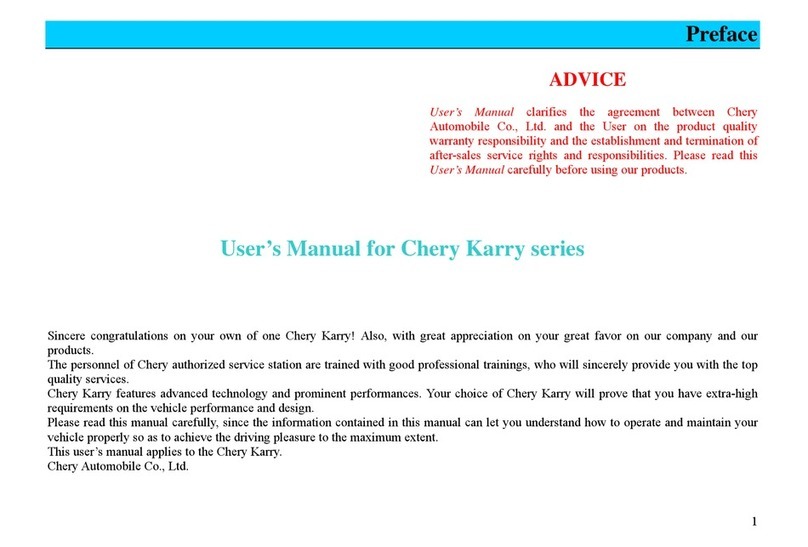
Chery
Chery Karry series User manual

Chery
Chery M16 Arrizo 7 2014 User manual

Chery
Chery TIGGO User manual
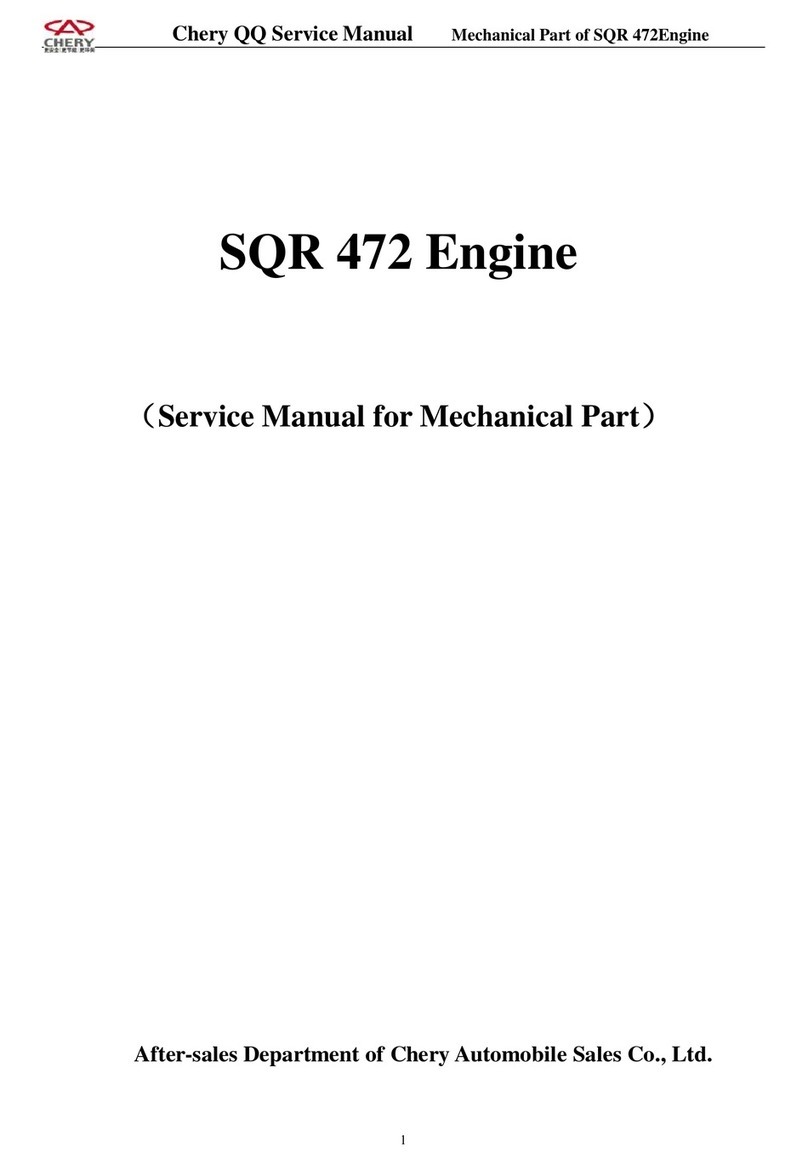
Chery
Chery QQ User manual
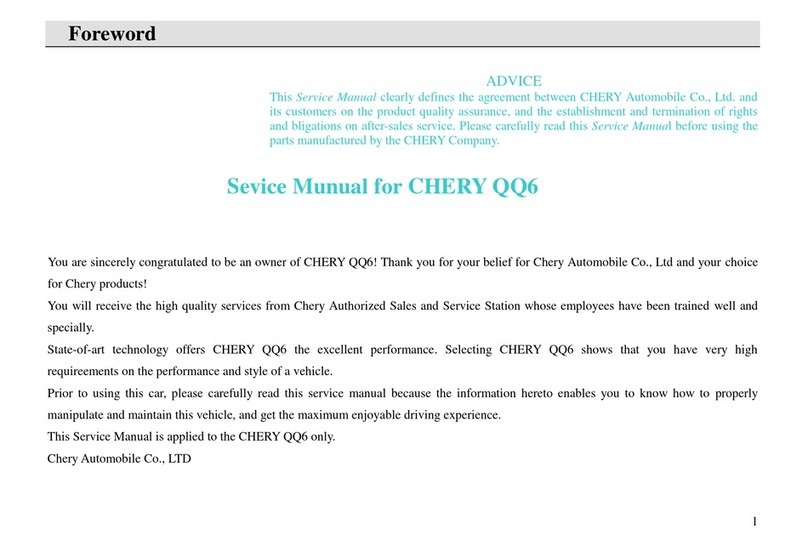
Chery
Chery QQ6 User manual

Chery
Chery Tiggo 2009 User manual
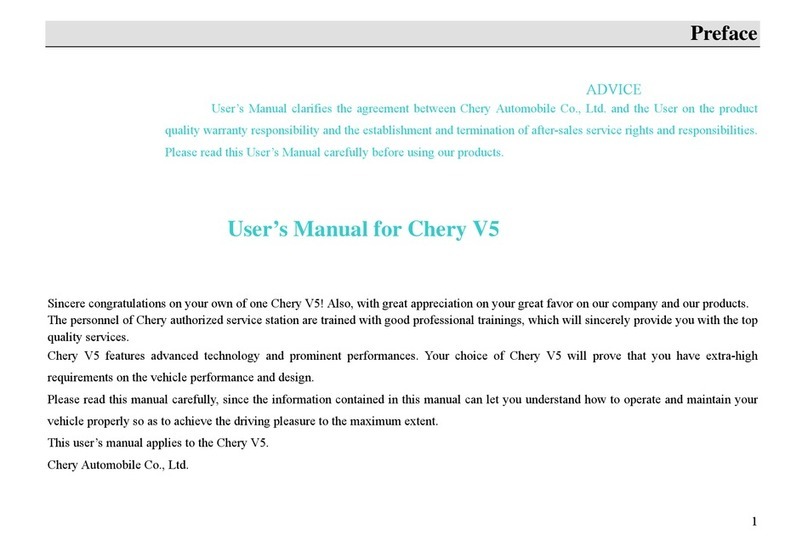
Chery
Chery V5 User manual

